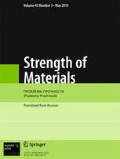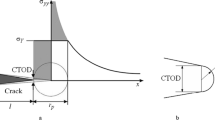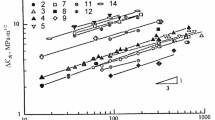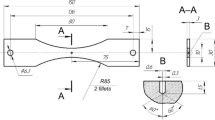The paper presents results of fatigue tests in the tension–compression and tension–tension modes of specimens of 45 steel: smooth specimens and specimens with a blind hole of different diameters of 0.6 and 1.6 mm. The fatigue resistance of specimens with a 1.6 mm hole is higher than that of specimens with a 0.6 mm hole. This is accounted for by the different mechanisms of reaching the endurance limit in both cases, which is a consequence of different gradients of local stresses in the vicinity of the hole. For the specimens with a smaller hole, the endurance limit is determined by the nominal stress for the initiation of a crack of the size not exceeding the grain size, as this is the case in smooth specimens too. For the specimens with a larger hole, the endurance limit is determined by the threshold nominal stress required for the propagation of a crack whose size is larger than the grain size. To theoretically estimate the endurance limit in the presence of a stress raiser in the form of a hole, the critical distance concept as a single parameter for a particular material can be successfully used, but if the radius of the hole does not exceed a certain critical value. A formula for the estimation of this value as a function of the material characteristic and theoretical stress concentration factor is proposed. The same formula can be used to determine the critical value of the theoretical stress concentration factor, above which the endurance limit in the presence of a stress raiser of the same depth and different sharpness remains unchanged.










Similar content being viewed by others
References
O. M. Herasymchuk, O. V. Kononuchenko, V. I. Bondarchuk, “Fatigue life calculation for titanium alloys considering the influence of microstructure and manufacturing defects,” Int. J. Fatigue, 81, 257–264 (2015).
O. M. Herasymchuk, “Modified KT-diagram for stress raiser-involved fatigue strength assessment,” Strength Mater., 50, No. 4, 608–619 (2018).
O. P. Ostash, “New approaches in fatigue mechanics,” Fiz.-Khim. Mekh. Mater., No. 1, 12–15 (2006).
M. D. Chapetti, “Fatigue propagation threshold of short cracks under constant amplitude loading,” Int. J. Fatigue, 25, 1319–1326 (2003).
L. A. Khamaza, “Determination of the crack size corresponding to the endurance limit of metals and alloys in the presence of a stress concentration,” Strength Mater., 50, No. 2, 235–245 (2018).
L. A. Khamaza, “Generalized diagram of the ultimate nominal stresses (endurance limit) and the corresponding dimensions of the non-propagating fatigue cracks for sharp and blunt notches,” Strength Mater., 51, No. 3, 350–360 (2019).
P. Lukáš and M. Klesnil, “Fatigue limit of notched,” Mater. Sci. Eng., 34, 61–66 (1978).
N. E. Frost, “Non-propagating cracks in vee-notched specimens subject to fatigue loading,” Aeronaut. Quart., 8, 1–20 (1957).
Acknowledgments
The authors are sincerely grateful to V. I. Bondarchuk, senior research assistant at the Kurdyumov Institute of Metal Physics, for his help during conducting fractographic investigations.
Author information
Authors and Affiliations
Corresponding author
Additional information
Translated from Problemy Prochnosti, No. 5, pp. 40 – 48, September – October, 2020.
Rights and permissions
About this article
Cite this article
Herasymchuk, O.M., Kononuchenko, O.V. The Range of Use of the Critical Distance Concept to Predict the Endurance Limit in the Presence of Stress Raisers. Strength Mater 52, 722–730 (2020). https://doi.org/10.1007/s11223-020-00225-3
Received:
Published:
Issue Date:
DOI: https://doi.org/10.1007/s11223-020-00225-3




